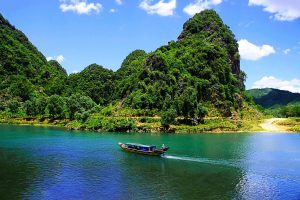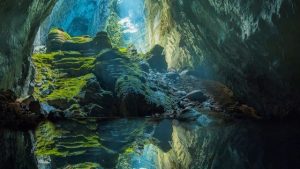Phong Nha National Park
The Phong Nha Ke Bang National Park, inscribed on the World Heritage List in 2003, covered 85,754 hectares. With this extension, the site covers a total surface area of 123,326 hectares and shares a boundary with the Hin Namno Nature Reserve in the Peoples Democratic Republic of Laos. Being formed approximately 250 million years ago by the oldest karst mountains in Asia and tropical forests, Phong Nha cave is the largest and most beautiful known cave in Vietnam. It features the great geological diversity and offers spectacular phenomena, including a large number of caves and underground rivers. The site harbours a high level of biodiversity and many endemic species. The extension ensures a more coherent ecosystem while providing additional protection to the catchment areas that are of vital importance for the integrity of limestone landscapes.
Outstanding Universal Value
Located in the village of Son Trach, Quang Binh province, Vietnam, it was designated as a UNESCO World Heritage Site in 2000. The property comprises an area of 123.326 hectares and contains terrestrial and aquatic habitats, primary and secondary forests, site of natural regeneration, tropical dense forests. It is remarkable for its thousands of meters of underground passageways and river caves filled with abundant stalactites and stalagmites. The karst formation has evolved since the Palaeozoic period and it is the oldest karst area in Asia. Subject to massive changes, the karst landscape is extremely complex, comprising a series of rock types that are interbedded in complex ways and with many geomorphic features. The karst landscape is not only complex but also ancient.
In 1990, a British caving expedition explored 35 km of the cave and made the first reliable map of Phong Nha’s underground passageways. They discovered that the main cavern is nearly 8 km long, with 14 other caves nearby.
The karst formation process has led to the creation of not only underground rivers but also a variety of cave types including of dry caves, terraced caves, suspended caves, dendritic caves and intersecting caves. With a length of over 44.5 km the Phong Nha cave is the most famous cave of the system with tour boats to enter a distance of 1500m. The Son Doong cave, fistly explored in 2009, is believed to contain the world’s largest cave passage in term of diameter and continuity. A large number of faunal and floral species occur within the property with over 800 vertebrate species recorded comprising 154 mammals, 117 reptiles, 58 amphibians, 314 birds and 170 fish.
 Phong Nha means Cave of Teeth and Wind, but, unfortunately, the teeth that were by the entrance are no longer there. Once you get further into the cave, it is mostly unspoiled. There is also a newly discovered dry cave just above the mountain containing Phong Nha cave. The Chams used the cave’s grottoes as Buddhist sanctuaries in the 9th and 10th centuries, the remains of their altars and inscriptions can still be seen. In the past time, the cave was used as a hospital and ammunition depot during the American War. The entrance shows evidence of fighter aircraft attacks.
Phong Nha means Cave of Teeth and Wind, but, unfortunately, the teeth that were by the entrance are no longer there. Once you get further into the cave, it is mostly unspoiled. There is also a newly discovered dry cave just above the mountain containing Phong Nha cave. The Chams used the cave’s grottoes as Buddhist sanctuaries in the 9th and 10th centuries, the remains of their altars and inscriptions can still be seen. In the past time, the cave was used as a hospital and ammunition depot during the American War. The entrance shows evidence of fighter aircraft attacks.
A high level of biodiversity is found within the site, with over 2700 species of vascular plants and over 800 vertebrate species. Several globally threatened species are also present: 133 plant species and 104 vertebrate species have been reported, including several large mammals such as the endangered Large antlered Muntjac, Clouded Leopard and the critically endangered Saola. The level of endemism is high, especially in the cave systems. Furthermore, it is estimated that over 400 plant species endemic to Vietnam are found within the property, as well as 38 animal species endemic to the Annamite range. Several new species to science have recently been found, including cave scorpions, fish, lizards, snakes and turtles and more species are likely to be discovered. Importantly, 4 threaten primate taxa endemic to the Annamites are found within the site: The Hatinh Langur, the black form of the Hatinh Langur, sometimes considered as a separate species, the Red Shanked Douc Langur and the largest remaining population of White cheeked Gibbon.
- ←
-
Email Us
Please send us an Email
